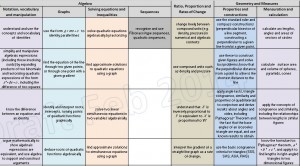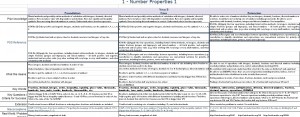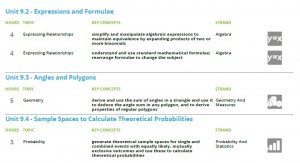You can view all the posts in the epic “Writing a Maths Scheme of Work” series on this page. It’s kind of like Game of Thrones, only with slightly less nudity and dragons.
Having decided upon the structure of our Scheme of Work, the next obvious step is to get the content and the order right. Now, as any one who has ever written a scheme of learning will know all too well, this is very much easier said than done.
Part of the problem is that the language used in the Key Stage 3 Programme of Study(released in September 2013) and the GCSE Subject Content and Assessment Objectives (released in November 2013) is quite hard to decipher. The latter document poses an additional problem in that some of the content is new, and although we have seen snippets of what it might look like, until the exam boards have their specifications and assessment materials approved, we won’t really know what we are dealing with.
Therefore, the logical thing might be to wait and see what happens. However, as next year’s Year 9 students will be the first to be examined on the new GCSE content, and we want to give our staff time to prepare, we wanted something in place for them for September.
The next option was to simply tweak what we currnetly have in place. However, tweaking is also easier said than done. It reminds me of an episode of The Restoration Man I watched the other night (I know, could I be any more of a geek?). They were restoring an old castle, and were doing loads of intricate work around this roof and it was taking ages. Then, one of the blokes said: “wouldn’t it just be easier to tear that bloody roof down and start from scratch”. The Restoration Man agreed that it would be, and so do I.
Sometimes it is best to simply start a fresh, and you may find it saves you time in the long run. If I am still blogging about writing this bloody scheme of work in 2 years time (and my frequency of swear words has increased exponentially), you will know that it wasn’t such a good idea :-/
So, having decided to start again with Year 9, we quickly realised that you can’t really plan for one year group in isolation without having at least a rough idea of what they will be studying in Years 10 and 11.
And so, before we embarked upon a huge cutting, sticking and deciphering task with the two documents above (and we had a trip to Tesco to stock up on wine, beer and vodka to get us through it), I spent an hour or so looking around the internet to see if there were any useful documents around to help us. And, thank God, there were!
New Schemes of Work from Kangaroo Maths
Links: to page and to document
Ever since I have been teaching, I have been regularly dipping in Kenny’s Pouch. Steve Lomax and Matthew Nixon provide a wonderful (free!) service, and once again they have produced the goods.
They have provided us with the content of the new curriculum mapped out from Years 1 to 11. I love the fact that each year group has its own tab so you can see their suggested content for that year group, or you can click on tabs to see how each main topic area progresses.
What I found particularly useful about this document is that it enabled us to cut, copy and paste (in the electronic sense) the content into our own blank Excel document so we could play around with different orders that suited us.
And with the promise of more detailed medium term plans to come, this document was a God send. Thanks guys!
Collaborative Maths Scheme of Work 2014
Links: to page and to document
Now, this is a wonderful idea. A group of teachers have decided to get together to break down the mammoth task of writing schemes of work for the new curriculum and share the load.
This project is still very much ongoing, but there is loads of great stuff up there already. The document I have linked to above is my personal favourite. Not only are the key points from the programmes of study laid out in a logical order, but they are also linked to really useful headings such as “what this means”, “key words” and “key questions”.
This document is not finished for all the 21 subject areas yet, but when it is this could be absolutely invaluable.
To find out more and to get involved in this exciting project, visit this page.
Medium Term Plans from LaSalle Eduction
Links: to website and to document
LaSalle education is the new company of Mark McCourt of emaths and NCETM fame.
Mark has kindly provided a set of Medium Term plans for the new maths curriculum for Years 1 to 9. These clearly define what content is to be taught in each year, and helpfully given suggested times. Mark has also said that Years 10 to 11 are on the way as well 🙂
So, armed with these three documents, Karen, Colm and myself intend on setting out what content we wish to cover in each year group, in what order, and how long for each topic. Once this is sorted, we can then get started on our individual responsibility areas of tasks, hoemworks and assessments. Fingers crossed we will be finished by the time they decide to change the curriculum again 🙂
A nice / strange image to finish
And on a final note, how about this from William Emeny.
In Will’s own words:
What you’re looking at is the GCSE Mathematics curriculum. Each node represents a topic, e.g. transformations, ordering decimal numbers, frequency polygons etc. There are 164 nodes in the diagram representing all topics on both the foundation and higher tier curriculum. The nodes are connected by 935 links. Each link represents a connection between two topics whereby one is the prior learning required to be able to access the other. For example, equivalent fractions is linked to adding fractions because you need to be able to do the former before you can learn how to do the later.
To find out more about this fascinating image and get a high resolution image, read Will’s blog post here





Dear Craig,
Thanks a lot for your invaluable and detailed information regarding your SOW project. I was trying to access the Collaborative Maths document and the plans from La Salle and in both cases I get an error message. Is there any other way I could get view them?
Kind regards,
Rafael
Hmmm… yes, they seem to have been removed. Kangaroo Maths are bringing out something new next week, I believe, which should hopefully do an even better job than these.